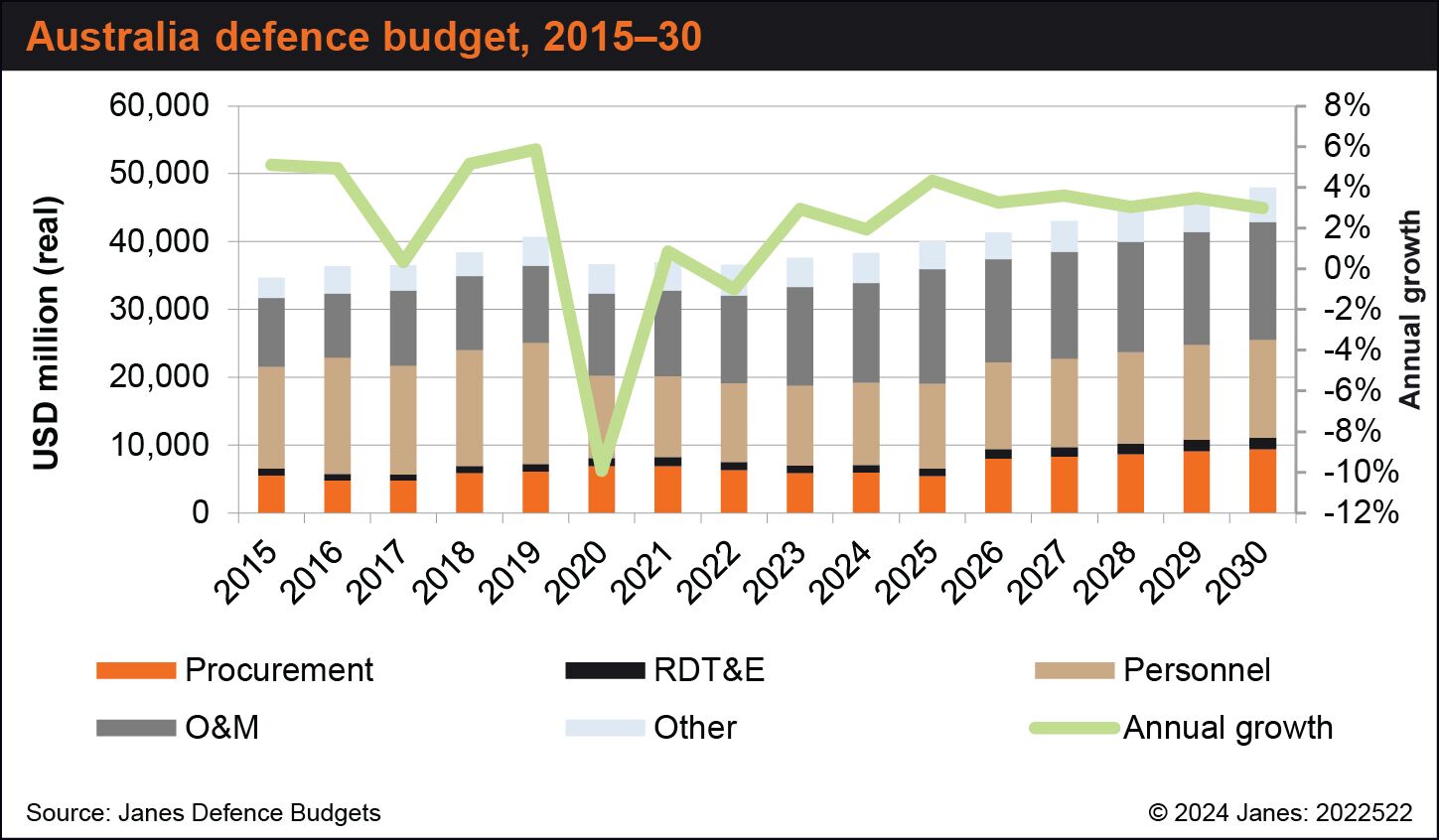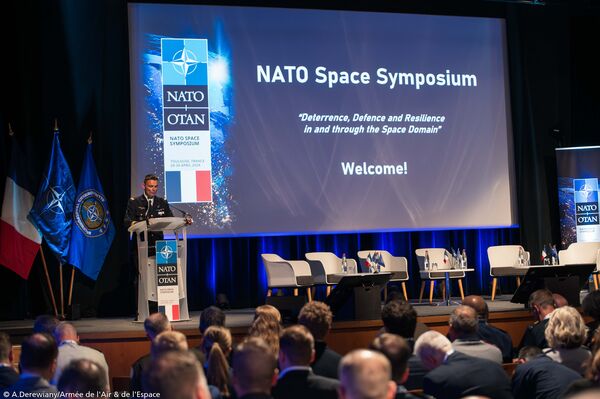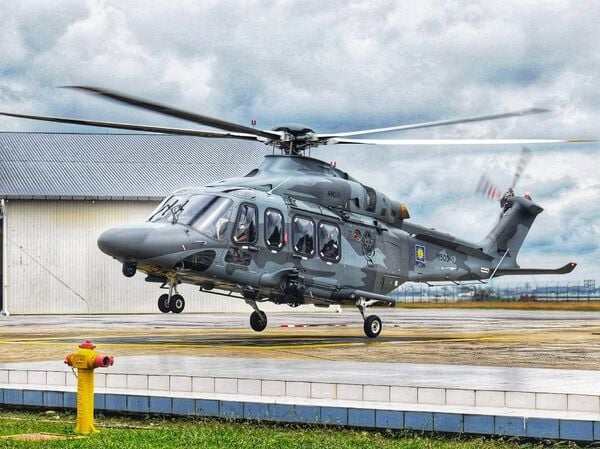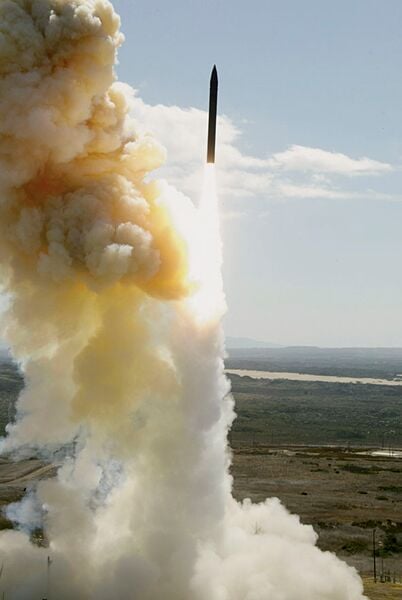- About
- Intara
- Capabilities
- Advisory
- Resources
- News
- Store
Australia launches defence industry strategy
29 February 2024
by Jon Grevatt


According to Janes Defence Budgets, Australia's total defence spending will rise from the equivalent of about USD38.4 billion in 2024 to nearly USD48 billion by 2030. About 19% of the annual defence expenditure is allocated to procurement. (Janes Defence Budgets)
Australia launched on 29 February a new strategy to enable local industry to meet the future capability requirements of the Australian Defence Force (ADF). The Department of Defence (DoD) in Canberra said the Defence Industry Development Strategy (DIDS) will shape Australia's industrial requirements in line with the Defence Strategic Review (DSR), which was released in April 2023.
“The DSR highlights the challenging strategic environment Australia faces and outlines the vision for [the ADF] to transition to an integrated and focused force,” the DoD said. “Defence industry is essential to delivering this vision. Defence industry supports our national security by delivering and sustaining the capabilities [the ADF] relies on.”
The DoD added that the DIDS establishes the “framework and principles” for Australia's defence industry policy. “These policy settings … deliver the initiatives required to develop Australia's sovereign defence industrial base required to meet our national security requirements,” it said.
NATO's inaugural Space Symposium kicks off in Toulouse
30 April 2024
by Olivia Savage


The inaugural NATO Space Symposium, held in Toulouse on 29 and 30 April 2024, aimed to bring key stakeholders together to stress the importance of the domain and highlight the key requirements among the alliance. (Armée de l'air et de l'espace)
NATO's inaugural Space Symposium has begun with senior NATO executives and space commanders from across the alliance as well as 44 companies in attendance to highlight the growing importance of space.
Held in Toulouse, France, on 29 and 30 April, the symposium aims to “bring all of the key players together to really understand where we are today, and where we need to go tomorrow”, both in terms of capabilities and policy, Lieutenant General David Julazadeh, the deputy chief of staff for Capability Development at Headquarters Supreme Allied Command Transformation (ACT), told Janes and other media representatives at the event.
This is necessary because NATO is “behind the power curve in space”, Lt Gen Julazadeh continued. The event is also about getting the alliance to think about “space as a physical domain” and not just an enabler, he added.
Two Royal Malaysian Navy helicopters collide mid-air
23 April 2024
by Ridzwan Rahmat


A file image of a Royal Malaysian Navy AW139 helicopter landing at Lumut. One of the airframes was involved in a 23 April 2024 accident that killed 10 personnel. (Royal Malaysian Navy)
Ten personnel are dead after two Royal Malaysian Navy (RMN) helicopters collided during a rehearsal for the service's 90th anniversary parade, the service disclosed in a media statement on 23 April.
All personnel are from the two helicopters involved, namely a Leonardo AW139 medium-lift rotorcraft and an AS 555SN Fennec airframe, the statement added.
The service has since confirmed to Janes that the AW139 bears the serial number M503-3 while the Fennec was registered with the serial number M502-5.
The aircraft collided at 0932 h local time while they were flying over the RMN's Lumut naval base.
A video of the mid-air collision that began circulating on instant messaging apps shortly after the accident indicates that the Fennec's main rotor clipped the AW139 on the latter's port side while both aircraft were making a right turn during a fly-past segment of the rehearsal.
Lockheed Martin snags multibillion-dollar NGI contract
16 April 2024
by Meredith Roaten


The Ground-Based Interceptor was launched from Vandenberg Air Force Base in California to simulate a combat launch from Fort Greely in Alaska. (Missile Defense Agency)
The Next Generation Interceptor (NGI) competition has come to an end as Lockheed Martin was selected as the prime to continue development of the weapon through critical design review (CDR), all-up round qualification, integration with the Ground-Based Midcourse Defense (GMD) system, and flight testing, the US Missile Defense Agency (MDA) announced on 15 April.
While no dollar amount was attached to initial statements on the contract, the Pentagon's Cost Assessment and Program Evaluation (CAPE) said in a 2021 report that it expected NGI to accrue roughly USD17.7 billion in contract costs. The downselect for Lockheed Martin will lead to a follow-on production and emplacement contract to support initial operational capability for NGI by the fourth quarter of fiscal year (FY) 2028, according to the announcement.
The MDA cited “technical maturity”, “technical rigor” in the design process, and contract-provided performance date as key factors that supported its decision.
Lieutenant General Heath Collins, director of the MDA, called the decision “very difficult” in a statement but said the agency was “confident”.
Australia launched on 29 February a new strategy to enable local industry to meet the future capabil...
Latest Podcasts
The value of OSINT for intelligence sharing
In this episode Harry Kemsley and Sean Corbett are joined by Phil Ritcheson Ph.D. to discuss why intelligence sharing is now more important than ever. They discuss the growing need for allied and partnership and how by using open sources facilit...
Listen nowJanes Case Studies
Using Janes Intara to build a common intelligence picture: Russian build up on the Ukrainian border
View Case StudyNews Categories
 Industry Details
Industry Details